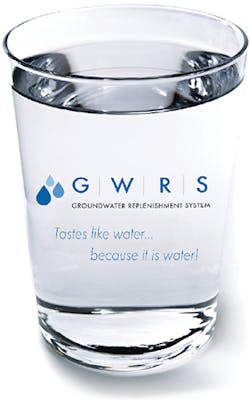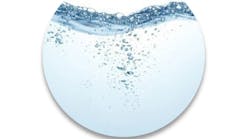Water is a precious commodity that the general population is just beginning to understand is in limited supply. Perhaps nowhere in this country is that fact more apparent than in California, where years of drought have resulted in land in the Central Basin’s farm belt sinking 2 feet a year.
It’s no surprise that California leads the nation in water conservation and recycling. State mandates require a 25% reduction in water use. Fines and penalties have been established and restrictions instituted.
The laws follow long-held beliefs and actions. “California has been recycling water for years,” says Ted Johnson, PG, CHG, chief hydrogeologist for the Water Replenishment District (WRD) of southern California. As part of its strategy, the State of California is promoting the use of recycled water for recharge. Recycled water has been used as a groundwater recharge source for the Central and West Coast basins for more than 50 years, and has proven to be safe and reliable. It’s also necessary for sustainability.
FROM THE GROUND UP
Local groundwater is the cheapest source of water, says Johnson, but without sustainable groundwater management, there will be shortages. WRD manages groundwater for approximately 4 million residents in 43 cities in southern Los Angeles County and monitors groundwater levels for the Central and West Coast basins.
Forty percent of the total water demand for this 420-square-mile area (roughly 250,000 acre-feet of groundwater each year) is taken from the aquifers of the Central and West Coast basins. The rest is imported from northern California and the Colorado River. However, 4–5 years of drought make it hard to import water.
The other problem is that more groundwater is pumped out than Mother Nature can replenish. It’s an old problem that began with over-population in the 1940s, states Johnson, and led to the creation of his department in the 1950s. Over-pumping is unsustainable. Severe overdraft has caused wells to run dry and has permitted seawater intrusion, which, in turn, contaminated groundwater supplies.
To combat the problem, Los Angeles County built spreading grounds next to rivers and seawater barrier walls and established laws to adjudicate pumping rights. It wasn’t enough.
“We mostly used imported water for a long time,” recalls Johnson, adding that the water table was down 100 feet at one point, but was “brought back to normal” in 1980 until another drought took it back down again. “Now we can’t get enough imported water.”
A fourth consecutive year of drought resulted in a net loss of groundwater from storage. WRD estimates it will need 103,300 acre-feet of replenishment water to overcome the annual overdraft.
“We had to find a balance,” explains Johnson. “In addition to reducing pumping and capturing rainwater, we had to add water to the ground, which we’ve been doing since 1959. The basin must be sustainable.”
Today, Johnson says, nearly half of the water in the Central and West Coast basins comes from Mother Nature; the other half is a combination of imported water and recycled, or reclaimed, water—treated wastewater. “We have to get over the yuck factor. All water is recycled. It’s all dinosaur drool,” he says.
REPLENISHING GROUNDWATER
Groundwater replenishment using recycled water is often used for replenishing groundwater basins to mitigate overdraft and increase yield. It’s a low-cost solution that is less complicated than other methods because it doesn’t require brine disposal. In addition, it promotes biocommunities that consume micro-pollutants.
Recycled water recharge is known as indirect potable reuse. It uses either surface spreading technology or direct aquifer injection. WRD has been using wastewater recharge since 1962. “We put in two million acre-feet, or about 650 billion gallons,” calculates Johnson. Extended drought periods underscore the need for recycled water for recharge. “If we don’t recycle it, the water goes to sea.”
It’s a complicated process that is heavily regulated for cleanliness, with extensive regulations, permits, controls, and monitoring to ensure protection of source waters, the environment, and human health. “Water from a treatment plant undergoes testing before it’s sent to the rechargefacilities, more testing underground, and further testing before going to the customer,” elaborates Johnson.
Soil aquifer treatment is a natural geopurification process that provides treatment and polishing during percolation and travel in the aquifer. It consists of a physical filter (soil), biological treatment (organics removal), chemical alteration processes (minerals and rocks), and residence or retention time (water underground for a period of time).
There’s a “minimal amount of work” in the three-stage treatment, which is not very different than treatment of regular sources of water, according to Johnson. “Wastewater in sewers goes to a treatment plant,” he begins. First, solids are removed via screens, filters, and settling tanks. Next, bacteria “chews up” organics. Then oxygen and bacteria are added to the water bath, creating a “big fancy mess.” The tertiary treatment includes sand filters and carbon polish before chlorine is added, and the water goes to a stream or spreading ground—lakes with sandy bottom, or “leaky lakes,”—Johnson calls them.
Sand, loam, and gravel are suitable for surface recharge areas, or “you can dig a well and inject it into the well,” says Johnson. “That can help the water pass through clay layers to sand layers, although in areas of poor soil, the water must be treated more aggressively with more filters and reverse osmosis.”
Wetlands can be part of the treatment system, particularly to remove metals. Wetlands slow water down. This helps make it cleaner. However, as Johnson points out, “plants drink a lot.”
The whole process, from the sewers to “clean enough for groundwater recharge,” takes less than a day. “It must be efficient to protect public health,” explains Johnson.
Locating treatment plants adjacent to manmade river channels in geology suitable for recharge expedites the process. One thousand acres of land treats 50,000 acre-feet of water per year; that’s 16 billion gallons per year of recycled water.
THE HIGH COST OF IMPORTS
WRD oversees 400 groundwater basins in the service area. These sand and gravel basins feature 20-inch diameter steel wells costing $1 million that are capable of pumping 2,000 gallons per minute.
“It’s been our savior,” says Johnson of the wastewater for recharge system. “If we didn’t have it, we would have to tap into imported sources.”
That could be an expensive proposition. “We don’t want to rely on imported water.” He estimates expenditures of $200 million for imported water, and says it takes three years to build new treatment plants to process recycled water.
Some areas in California saw groundwater levels fall nearly 4 feet last year due to drought. Despite the lack of rainfall, conservation efforts—including pumping restrictions, El Niño, and other programs—were responsible for a rebound in groundwater levels in other areas. Nevertheless, overall groundwater storage loss in the district was 12,700 acre-feet, forcing WRD to purchase imported water for recharge.
The only way to reduce reliance on imported water is by using recycled water to recharge the aquifer. Reducing or eliminating the need for the more expensive (and less reliable) imported water by using more of the less-expensive recycled water for groundwater replenishment is the basis of WRD’s Water Independence Now program.
According to WRD estimates, the cost of replenishment water last year was $42,034,686, which is nearly the same amount spent the previous year, a fact attributed to the difference in cost between recycled and imported water.
WATER IN THE FORECAST
Climate change is reducing stormwater and captive rainwater opportunities. Drought reduces the availability of imported water. “Climate change will affect our water supplies. There will be even less water if it gets warmer,” points out Johnson.
Population growth will increase demand for this limited resource, although it’s been held in check to some extent, thanks to conservation efforts. “We’re using the same amount [of water] now as in the 1970s due to conservation efforts,” reveals Johnson. He credits a wide array of programs, technologies, and other restrictions, including low-flow showers and toilets, no-water urinals, car washes reusing water, replacement of grass lawns with native vegetation, and replacement of concrete with permeable surfaces, and natural plantings.
“We have to do less pumping and more recharge to balance unsustainable basins,” says Johnson. He also advocates better managing and monitoring of water resources. That includes reusing and recycling wastewater through aquifer recharge. Reusing wastewater has no negative impact on the aquifer, he states. Recycled water “just becomes part of the water supply. It’s not a waste,” he says. “It’s a resource.”
SAME STORY, DIFFERENT DISTRICT
There’s no disagreement from Mehul Patel, P.E., director of water production/GWRS for the Orange County Water District (OCWD) in Fountain Valley, CA. Water is a precious resource in short supply.
“It’s an El Niño year, so we’ve had heavier precipitation,” Patel notes. “Two weeks of heavy rain filled the reservoirs in northern California and added to the snowpack in the Sierra Nevada, which is our source of import water. But water levels are still below average in SoCal.”
That’s a problem for a groundwater agency responsible for protecting the basin’s water quality, managing pumping, and replenishing what is taken out.
As a public agency, OCWD provides wastewater collection, treatment, and recycling and manages the Orange County Groundwater Basin, which provides approximately 76% of the water supply for approximately 2.5 million people in central and northwest Orange County. Designated as a special district, OCWD has two operating facilities that treat wastewater from residential, commercial, and industrial sources.
The area served is virtually the same area as the groundwater basin that provides most of the water residents rely upon. “Drinking water is mostly groundwater. Groundwater is the source of water for a lot of people,” relates Patel, adding that water sources are a combination of local river water, recycled water from their plant, and untreated water they purchase.
Because so many rely on groundwater, Patel says the District worries about over-drafting the basin. Historically, it’s been an issue. Sinking land due to over-drafting led to management laws. However, despite state laws regulating usage, mandatory conservation requiring a 25% reduction in water usage, and even with population growth less than predicted, water shortages are a concern.
PUMP UP THE VOLUME
“A big part of our job is to determine how much pumping will be allowed,” explains Patel. A 10-member board of directors determines the basin production percentage and sets the price, as well as the penalty for going over the allowed percentage.
Created by the state as a special district, OCWD focuses on providing reliable water in an environmentally friendly and economical manner. The two main aspects of its job are to put water in the ground and protect water from seawater intrusion—challenging work because the basin extends to the coast. “Since the mid-70s, we’ve been injecting water near the coast,” indicates Patel. Doing so creates a hydraulic barrier against seawater intrusion and serves as a source of replenishment.
They’re injecting even more now, thanks to a pipeline that connects the field operation to the treatment plant through a series of rivers and lakes, which make the recycled water “ultra-pure.” There is “some natural treatment through the soil,” admits Patel. Soil polishes, but he says that it “dirties up ultra-pure water.”
Their original permit required six months of travel time. “It was easy to meet; it takes a long time to travel,” says Patel.
Even inland areas, where sandy, silty soils—like water—sink quickly, move water slowly. It will be “a couple years” for water to reach most of the wells. A study, with 3D groundwater modeling, helps illustrate how long it takes for water to travel. “We monitor the wells and the flow path.”
Regulations were revised this year. With “a lot of treatment,” water can be reused after only two months now, although Patel thinks it will still be longer before it is. No matter how fast the travel time, he says it’s important to keep it moving. “It’s hard to keep water fresh when it’s sitting.”
The steps that OCWD takes to prepare recycled water are similar to those used by the WRD: microfiltration to remove bacteria and solids, reverse osmosis to create a very pure quality of water, a high level of ultraviolet light with hydrogen peroxide for advanced oxidation, and then the addition of minerals back in.
“Microfiltration is a separation process that uses polypropylene hollow fibers, similar to straws, with tiny holes in the sides that are 0.2 micron in diameter [1/300 the diameter of a human hair],” explains Patel. “By drawing water through the holes into the center of the fibers, suspended solids, protozoa, bacteria, and some viruses are filtered out of the water.” Evoqua Water Technologies makes the microfiltration membranes used at the facility.
“Reverse osmosis [RO] membranes are made of a semi-permeable polyamide polymer [plastic],” explains Patel. During the reverse osmosis process, water is forced through the membranes under high pressure, removing dissolved chemicals, viruses, and pharmaceuticals. Patel says that the RO membranes utilized throughout the GWRS are from a variety of different manufacturers including Hydranautics, DOW, and CSM, a local manufacturer. On an ongoing basis, OCWD tests various membranes to compare their efficiencies.
To disinfect and to destroy any trace organic compounds that may have passed through the reverse osmosis membranes, water is then exposed to Trojan Technologies’ high-intensity ultraviolet light with hydrogen peroxide (H2O2). This process serves as a safety barrier, Patel explains.
The District treats 100 million gallons a day (mgd). Of that amount, 30 mgd are injected into the coast, and 30 mgd are spread in ponds. OCWD bought large parcels of nearby land in order to surface-spread in permeable soil.
“Coastal cities get some water; the aquifer gets some water,” says Patel. “The drought cycles are longer and more extreme, so we will always put water into the basin, even if we get rain.”
A PARTNERSHIP THAT’S ALL WET
The District has a partner in supplying more than 182 billion gallons of high-quality water to Orange County, a region plagued by severe drought: the Orange County Sanitation District (OCSD). Together, they created the Groundwater Replenishment System (GWRS), a model for water supply reliability, and expanded it to produce an additional 30 mgd daily. This makes it the world’s largest water reuse project of its kind, providing water to 850,000 people annually.
The project takes treated wastewater supplied by OCSD at no cost and purifies it through a three-step process consisting of microfiltration, reverse osmosis, and ultraviolet light with hydrogen peroxide. The end result is 100 mgd of ultra-pure water that meets or exceeds state and federal drinking water standards.
A portion of the water is injected into a seawater barrier. The remainder is pumped to OCWD’s recharge basins where it percolates into the Orange County Groundwater Basin and becomes a primary source of drinking water. About one-third of the water used to replenish the basin comes from the GWRS. Other sources of water used to fill the basin include imported water, Santa Ana River water, and stormwater.
Before the project was launched, groundwater pumping was restricted to 62% of total water demands. Today, while other California communities are grappling with significant shortages due to the four-year drought, the GWRS has helped increase groundwater pumping in the Orange County Groundwater Basin to 76%.
Despite that increase, plans are in the works for a final expansion of the GWRS. Ultimate capacity for the project is projected at 130 mgd after infrastructure is built to increase wastewater flows from OCSD.
RINSE AND REPEAT
According to experts, injecting reclaimed water into the ground has no adverse effects on the aquifer. On the contrary, they feel that it’s beneficial on many levels. “It keeps sea water out and raises the level on the coast,” says Patel, adding that similar technology is used in the Midwest, but for different reasons—namely, battling contamination from flooding.
Injecting water allows them to maintain a “working level” in the basins—not full to the brim in order to prevent flooding and artesian wells, while granting a cushion for heavy rain years and excess import water on sale. “We like to ‘bank it’ when it’s available—open a spigot on the pipeline and fill empty basins.”
Because regulators worry about a greater potential for contamination from reclaimed water, Patel says OCWD goes above and beyond drinking water standards. “To protect public health, there are a lot of treatments, a lot of monitoring. Tap water is the most regulated water out there. It has to meet EPA regulations, unlike bottled water, which is overseen by the FDA.”
Man taints water, acknowledges Patel. Because it’s “hard to fill it up when it’s gone,” he says we must learn how to manage water. “All cities have ordinances in place to manage our water supply.”
The technology being used is relatively new and comes chiefly from the food, beverage, and microchip industries. “It was used for industrial ultra-pure water until we realized it’s also good for municipalities,” explains Patel. “There’s less margin in this industry, but they sell more equipment.”
Variations on existing technology are being developed and new technology is on the horizon. Patel expects it to come from the oil and gas industries this time because they are accustomed to filtering to a high degree.
It’s important to remember that all water is recycled, Patel concludes. “Seventy treatment plants discharge into the Colorado River, which is the source of import water for much of southern California.”




